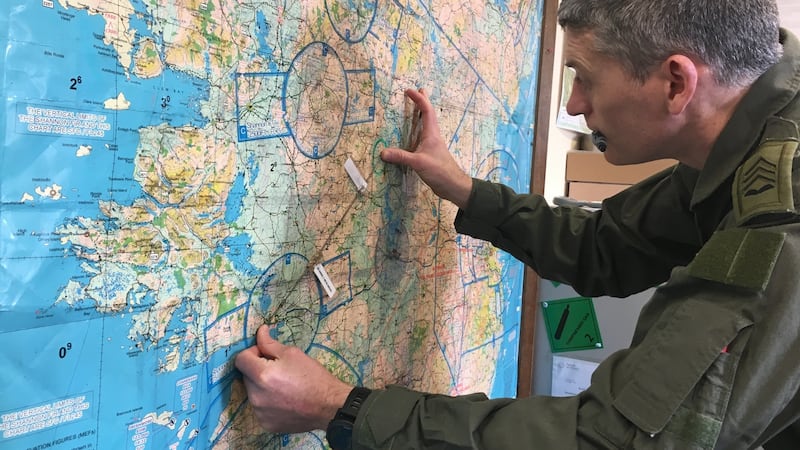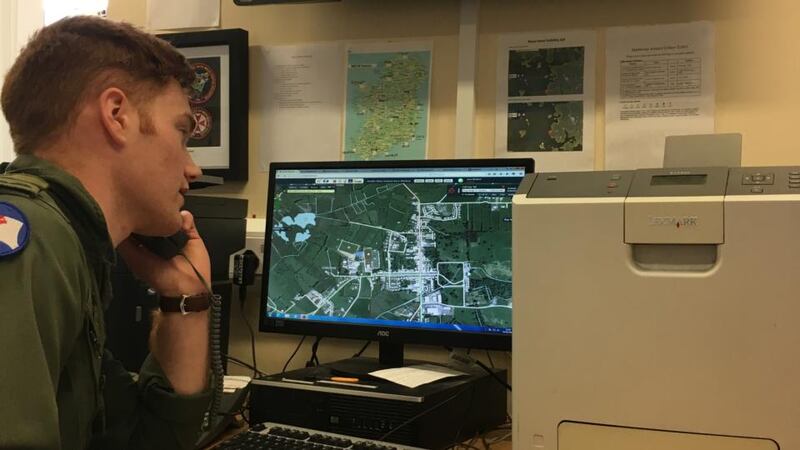Air Corps 112, an Emergency Air Medical Service AgustaWestland 139 helicopter, swayed slightly during the first few feet of its rise from the parade ground in the centre of Custume Barracks in Westmeath.
Then, after a moment’s pause, it rose firmly while simultaneously (and disconcertingly) moving backwards.
Hovering perhaps 300ft above ground for a few seconds, it then tilted forward, nose down, and wheeled right.


Advanced Paramedic Darren Figgis (44) calls the National Ambulance Service co-ordinating centre in Tallaght, Dublin, and tells Ruth Hanly, his dispatcher, that we are on the way – “five souls on board,” as he puts it.
The Helicopter Emergency Medical Service (Hems), which has been going since June 2012, is a partnership between the Air Corps and the Health Service Executive.
It is “a clinical solution to a political problem”, as Figgis wryly puts it, following the downgrading of Roscommon hospital.
The Air Corps provides the helicopter and crew; the ambulance service provides the medical expertise.
So far, they have been called out more than 3,300 times and have airlifted in excess of 1,700 patients – over 750 heart attack patients, 555 crash and other trauma victims and 115 children.
By the time they are back at base, they often get calls from the receiving hospital, telling them that patient such-and-such has had the stent and is sitting up in bed: “The savings – costs and hospital time – are huge,” says Figgis.
Before taking off, Comdt Phil Bonner does an on-the-ground walk around check of the aircraft, checking rotor blades, engines, latches, and so on, including the Crash Position Indicator – one he hopes will never be used.
Check everything
Shortly afterwards, Bonner (39) and his co-pilot P2, Lt Kevin Fitzgerald (26) – get into the cockpit and assume the aircraft is not fit to fly. To prove themselves wrong, they check everything.
In an exhaustive run, every switch and button is checked and double-checked: engine start, fuel, pressure, check, the gas turbine and exhaust temperatures, torque.
The list goes on – hoist, hydraulics, blades, a variety of pumps, and the all-important flight management control system until, finally, the umbilical connection to the ground battery can be disconnected and they are ready for the off.
In a move to break down barriers that exist between ranks, first names only are used onboard, not titles: “It is to encourage all ranks to question decisions – there’s no room for group-think on a helicopter,” Comdt Bonner says.
Everyone onboard thinks not just of what they are doing now, but what they will do next.
In the event of a crash that one survives, “never leave the craft while the blades are running”, adds Sgt Damien Kelly (38), the man responsible for what goes on in the cabin, the loading and unloading of passengers and patients, and providing detailed navigation assistance to Bonner and Fitzgerald.
He’s also good at guiding what’s called handrailing – shepherding the helicopter flying very low and using power lines for directional guidance.
09.20hrs: Operations room weather briefing. Lt Fitzgerald goes through the readings from MET stations at Malin, Gurteen, Birr, Johnstown Castle and Shannon. There are no problems envisaged for the day.
Bonner speaks, addressing all present. “Any issues with illness? Medications? Stress? Alcohol? Fatigue? Everybody happy, fit for service?” Everyone says they’re fine.
“Equipment? Darren, happy with your gear? Damien, happy with your gear? Tech issues? Any tech issues from yesterday? Hospital availability?” Figgis gives the run-down on which hospitals are taking patients.
Training run
The rest of the morning is spent mostly on a training run, south to Laois, before Figgis takes the first real call, which comes in at 13.05hrs, a cardiac arrest at Burnfort, near Mallow. He hits the alarm.
Fitzgerald calls up Health Atlas Ireland, a dynamic, real-time digital map that can simultaneously track Coast Guard helicopters and Medical Evacuation aircraft, fixed wing and helicopter.
It can be watched by the Athlone Ops Room and Tallaght ambulance control centre. It uses LatLong (map co-ordinates) and Eircodes to identify locations, as well as Google Earth.
The map also shows PDLZs (Predetermined Landing Zones for the helicopter), indicated by red circles and which are often playing pitches or fields previously successfully used as landing spots.
Click on the circle, and up comes the co-ordinates; drill deeper and the crew is looking at the hedges and telegraph poles around the prospective landing site.There are 4,500 landing spots logged so far across the State.
Fitzgerald hits the print button before running out, clutching an image of the landing site and all relevant details including map co-ordinates and obstacles.
At 13.12hrs, while still on the ground, the crew is stood down by Tallaght; there is an ambulance on scene.
At 15.05hrs, Tallaght calls again: there’s a 10 delta (chest pains and sweat) in Strokestown.
Within five minutes, we are airborne and, as we skirt around Slieve Bawn and descend onto a playing field, Kelly is leaning right out of the open helicopter door, guiding Bonner and Fitzgerald down “down six, down five, down four, down three, down two . . .”
And as we hit the spot, Tallaght calls, telling the crew to stand down once more.
Stood down
The calls keep coming: a 16.03hrs call to Scotstown in Monaghan, one at 17.17hrs to north Mayo, and a 18.25hrs call-out to a crash near Castlecomer in Kilkenny. Each time, they were stood down.
The day before, the crew airlifted several patients to hospital, and again the day after – the notes of appreciation from patients, or their families regularly arrive in the Ops Room.
But on this day, there would be no rush of adrenalin, no satisfaction of help given.
The multiple orders to stand down leave the crew a little disappointed. In all, they flew for four hours and five minutes, carried out two training exercises, but picked up no patients.
The elderly man near Mallow, the younger man in Strokestown, the old woman in Scotstown, those injured in the crash near Castlecomer, and the mother in Mayo, probably didn’t know, and don’t know still, the huge efforts that were made to help them by a diverse range of really skilled people.
The crew of Air Corps 112 were disappointed. But they’ll get over it. They were there, ready when needed. They answered the calls. Like they do every day.

















